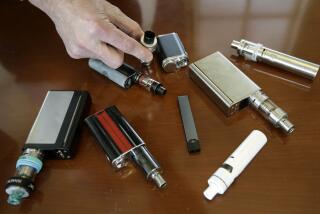Smoking Among Youths Continues to Rise
Joe Camel has been retired. A pack of cigarettes can cost more than a fast-food lunch. A new tax that became effective Jan. 1 has pushed the price even higher. Yet smoking among young people is on the rise.
Maybe Joe Camel was not the pied piper after all--the one who started young people down the path to nicotine addiction. Young people ages 16 to 24 interviewed across Southern California say it was often someone in their family who led them down that road, usually a relative they wanted to emulate, or a friend.
“I hated smokers and smoking until I was 18,” said Joe L’Hote, 22, of Newport Beach. “I didn’t like anything about it. But one day I was stressed, smoked a cigarette with friends, and I’ve been smoking ever since.”
Ramon Vega, 20, of Los Angeles said an older cousin gave him his first cigarette.
Joyce Arvizo, 21, has smoked since her brother offered her a first cigarette when she was 12. “Everybody in the house smoked,” she said. “It was just an everyday event.”
“Just watching my mom and dad and everybody else made me want to try it,” said 17-year-old Barbara, who declined to give her full name.
Some young people are social smokers, lighting up only at parties or when they go out.
James Sims, 25, of Costa Mesa said: “I started smoking eight years ago, and it wasn’t because of billboards and tobacco products. At the time I was drinking a lot and it was the social thing to do.”
The extensive evidence that smoking causes health problems often fails to make an impression on young smokers.
“I quit for a while because I started getting shortness of breath on hiking trips and things like that. But I started up again,” Sims said.
Yoichi Itagaki, 20, said: “I don’t really care about my health. I think it’s OK. I smoke at parties. It’s cool.”
Jasmina Koev, 16, of Newport Beach said, “I used to run 6 miles a day, but now I can’t run 200 yards without coughing. . . . I know I have to cut down.”
Steve Sussman, an associate professor of preventive medicine at USC, said young people typically don’t pay attention to the links between smoking and adverse health effects.
“When kids see people smoking, they don’t see them dropping over dead,” he said.
After the initial curiosity, the ability to smoke becomes a skill, an accomplishment, Sussman said. “The kid gets more experience, doesn’t get sick anymore,” he said. “There’s a physiological reward. When they think they have learned how to use tobacco, it really means their bodies have given up their warning signs like coughing and nausea.”
Nationally, the number of adolescents who become daily smokers before the age of 18 increased by 73% between 1988, the year of Joe Camel’s debut, and 1996, according to the national Centers for Disease Control and Prevention. Each day, 3,000 youths under 18 become daily smokers, the CDC said.
Meanwhile, the smoking rate for people 18 and over has fallen from 42% in 1965 to 25% in 1995, the CDC reported.
Smoking among college students rose 28% between 1993 and 1997, according to a Harvard University study. Among the smokers, the same study found, about half tried to quit in the past year.
Cheryl Balolong, 19, said she’s trying to quit, now that she has been diagnosed with chronic bronchitis. She’s getting a little support from her friends. “My friends don’t offer me cigarettes, but if I beg them, they’ll give me one,” she said. “They want to quit but it’s hard.”
Quitting was easy for Lizette Guerra. “I had no withdrawal,” said the 22-year-old anthropology student at L.A. City College. “Now the smell irritates me. When I smoked in high school, it was a phase. All my friends smoked, so I thought, ‘Why not?’ ”
“I hate the fact that I smoke,” said Shawn Enos, 24. “I don’t even like it anymore. I’m just addicted.”
Ramon Vega used to enjoy smoking because he wanted to be like James Dean or Robert DeNiro or any of the celluloid tough guys that a chorus of his buddies yelled out as he described what influenced him to smoke.
But a more immediate role model persuaded him to stop. He saw his grandfather sick with emphysema and decided to quit. “I was addicted,” said the L.A. City College student. “But now when people smoke in front of me, I just have to leave.”
Like many of his peers, Vega started smoking out of curiosity. “Every teen thinks it’s cool. They want to be there,” he said.
Sussman said the “quit rate” for adolescents is half of what it is for adults. “In the past, teen cessation [programs were] considered a fruitless task,” he said. “There just wasn’t the funding for it.”
He said young people trying to quit need the support of their families and peers, when the pain of withdrawal can be trying even for the most patient parents.
Pain is something new for young people, Sussman said. “Adults are used to hurting. Kids don’t like to hurt as much.”
Sussman thinks designers of smoking cessation programs should accommodate young smokers’ lifestyles. “Kids don’t keep appointment books,” he said. “Have something they can go to right after school--at their school, not at another site.”
Some young smokers say they have no intention of quitting, but the new Proposition 10 tax, which raised the price of cigarettes by 50 cents a pack, may make them cut back on the amount they smoke.
“Do you know what people are doing now? They’re not buying them; they’re bumming them off friends, “ said L’Hote of Newport Beach.
Arvizo says she now thinks twice about how much she smokes. She said recent price hikes have made her and her friends buy fewer cigarettes.
Others buy their cigarettes at discount stores that sell them for around $2.50 per pack. Brand name cigarettes can go for nearly $4 a pack, or more.
Price increases are effective in reducing teenage smoking, said Jonathan E. Fielding, Los Angeles County director of public health. “I think the combination of Proposition 10 and the tobacco lawsuits will definitely change the slope of the curve.”
Fielding said he thinks that Proposition 10 will result in 75,000 fewer new smokers under 18 in Los Angeles County each year and that will translate into 25,000 fewer premature deaths.
A 1996 UC Irvine study showed that when teenagers see one 30-second anti-smoking ad before a film in which smoking figures prominently, at the end of the movie, they will perceive smoking as unglamorous.
“One of the most serious problems is the increased smoking in TV and feature films,” Fielding said.
More to Read
Sign up for Essential California
The most important California stories and recommendations in your inbox every morning.
You may occasionally receive promotional content from the Los Angeles Times.









